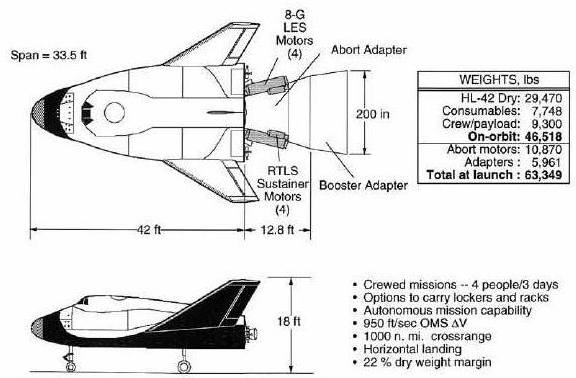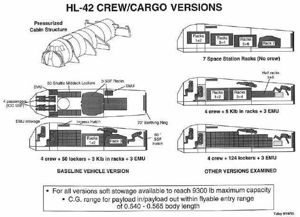
Home - Search - Browse - Alphabetic Index: 0- 1- 2- 3- 4- 5- 6- 7- 8- 9
A- B- C- D- E- F- G- H- I- J- K- L- M- N- O- P- Q- R- S- T- U- V- W- X- Y- Z
HL-42

HL-42 Configuration
Credit: NASA
Status: Design 1997. Payload: 4,300 kg (9,400 lb). Gross mass: 21,093 kg (46,502 lb). Unfuelled mass: 19,093 kg (42,092 lb). Specific impulse: 300 s. Height: 12.80 m (41.90 ft). Span: 10.21 m (33.49 ft).
Despite extensive study of the concept by NASA Langley in the early 1980's, it was seen as a threat to the shuttle and went no further than the mock-up stage.
The 1997 HL-42 design (HL = horizontal landing) stemmed directly from the HL-20 lifting body vehicle concept studied at Langley Research Center from 1983. It was a 42 percent dimensional scale up of the HL-20, hence the designation HL-42, and also happened to have a body length of 42 feet. It retained key design and operational features of the HL-20 design. The applicable HL-20 design data base included extensive in-house aerodynamic, flight simulation and abort, and human factors research as well as results of contracted studies with Rockwell, Lockheed (Skunk Works), and Boeing in defining efficient manufacturing and operations design and auto-land capabilities.
The HL-42 reference vehicle was a reusable, lifting body spacecraft designed to be placed into low-Earth orbit by an expendable booster. Launch escape motors for use in the event of an abort were attached to the expendable launch vehicle adapter at the base of the HL-42. The spacecraft had a dry mass of 13,365 kg, an on-orbit mass of 21,093 kg, and a launch mass (with booster adapters and launch escape system) of 28,725 kg.
The core of the HL-42 design was an aluminum-lithium, cylindrical, pressurized cabin which contained the crew and/or cargo. It had ingress/egress hatches at the top and rear of the cabin. Docking at the space station occurred at the rear of the HL-42. A 1.27 m space station hatch permitted loading and unloading of cargo as large as space station racks. Extending from the pressurized cabin were frame extensions which supported the lower heat shield structure and defined subsystem bays. A graphite polyimide heat shield structure defined the underside of the HL-42 with the TABI TPS bonded directly to the structure. The upper surface was composed of aluminum lithium removable panels that defined the required aerodynamic shape and allowed access to the subsystems located in the unpressurised bay areas. Shuttle flexible blanket insulation (FRSI) TPS was bonded directly to these panels. The graphite polyimide fins had direct bond TPS (TABI and FRSI) with the addition of advanced carbon-carbon (ACC) for the higher heating leading edges. The vehicle nose cap was also made of ACC.
Flight control consisted of seven moving surfaces -- four body flaps, two elevons on the large fins and an all-moving center vertical fin. Control movement was effected using electromechanical actuators. Spacecraft power was supplied by Shuttle-derived hydrogen-oxygen fuel cells with limited emergency power backup provided using rechargeable silver-zinc batteries.
The HL-42 did not have a main propulsion system. HL-42 propulsion consisted of a methane (CH4) - liquid oxygen (LOX) orbital maneuvering system (OMS) and reaction control system (RCS) for multi-axis attitude control on orbit and during entry. The CH4-LOX system was selected as a result of the no hypergolic propellant ground rule.
The reference HL-42 was a low-risk technology design. Many subsystems were either direct, off-the-shelf designs or based on existing designs. The only exceptions were in the areas of propulsion (new CH4-LOX systems) and health monitoring avionics. Technologies supporting a 1997 development included aluminum lithium structures, graphite polyimide TPS substructure and fins, and TABI TPS.
Mission Description
Ascent
The HL-42 spacecraft was launched by an expendable booster into a 28 x 405 km injection orbit inclined at 51.6 or 28.5 degrees. The OMS capability was 290 m/s, consistent with maneuvers required to transfer to a 405 km space station orbit, circularize, rendezvous, and de-orbit. Various combinations of crew and cargo (space station racks, early-late access lockers, and EMU suits) up to the 4,300 kg limit could be carried by HL-42 in the pressurized cabin volume
Abort
Crew safety and intact vehicle recovery were two aspects of abort which were addressed by the HL-42 design. The launch escape motors located on the launch vehicle adapter provided a high thrust impulse to rapidly distance the HL-42 from the site of a catastrophic booster failure. While the HL-42 was on the launch pad and during the first 60 seconds of ascent, these abort motors provided for a return-to-launch site (RTLS) capability and an intact runway landing. The booster also provided an additional RTLS capability beyond this initial period. Thereafter, single-engine out transatlantic (TAL) and abort-to-orbit (ATO) options existed throughout the remainder of the ascent powered trajectory. Some booster options had a portion of the ascent where the abort mode resulted in an ocean ditching using emergency parachutes on board the HL-42. Under these conditions the crew was saved, but the vehicle was considered expendable (not refurbished if recovered). Based on the flight rate, this event was estimated to occur only once in the mission model with this vehicle attrition accounted for in the fleet sizing.
Entry
The entry trajectory of the HL-42 was designed not to exceed the temperature capability of the thermal protection system, to not exceed a total acceleration of 1.5 Gs, and to provide a cross-range capability in excess of 1850 km. The entry thermal environment of the HL-42 was similar to that of the HL-20 which had been studied extensively. However, because of its larger dimensions, the heating expected on the nose and fin leading edges was expected to be less severe than on HL-20. The center-of-gravity of the vehicle with payload in or out was within the flyable range based on the extensive HL-20 aerodynamic data base. The large cross-range capability of HL-42 permitted multiple daily landing opportunities at the launch site, or every orbit landing opportunities if five landing sites were selected from the current list of available Shuttle landing sites.
Servicing Towed Package
To provide for a servicing mission capability, it was assumed one vehicle of the HL-42 fleet would have modifications for an airlock system within the vehicle and inclusion of an RMS servicing arm which telescoped into the base and was housed in the unpressurised service bay area. The servicing mission HL-42 also included a servicing kit which was towed attached to the HL-42. This towed package included:
- Additional OMS/RCS LOX/methane propellants to provide a total orbit maneuver capability to the vehicle of 2980m/s (including reserves).
- 1000 kg of hydrazine propellant to refuel the satellite being serviced
- Tanks, pressurization and feed, and propellant transfer systems for the above
- TPS to maintain thermal balance
- A radiator to reject excess heat during the 7-day mission
- A fixed link for satellite hold-down during servicing
- Servicing structure
The servicing kit was housed inside the launch vehicle adapters during launch. During ascent, the adapters split apart exposing the towed package. In a launch abort, the towed package links to HL-42 were severed, and the package was left with the launch vehicle.
Crew Size: 4. RCS total impulse: 56,800 kgf-sec. Spacecraft delta v: 290 m/s (950 ft/sec).
Family: Spaceplane, Suborbital, US Rocketplanes. Country: USA. Launch Vehicles: Titan. Propellants: Lox/LCH4. Agency: NASA, NASA Langley. Bibliography: 363.
 | HL-42 Crew/Cargo HL-42 Crew/Cargo Versions Credit: NASA |
Back to top of page
Home - Search - Browse - Alphabetic Index: 0- 1- 2- 3- 4- 5- 6- 7- 8- 9
A- B- C- D- E- F- G- H- I- J- K- L- M- N- O- P- Q- R- S- T- U- V- W- X- Y- Z
© 1997-2019 Mark Wade - Contact
© / Conditions for Use